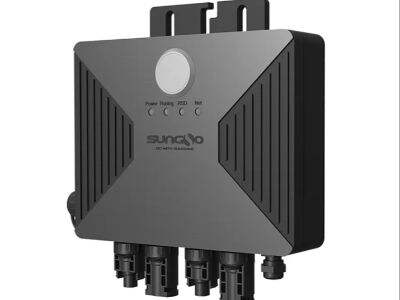إذن إليك الإيجابيات والسلبيات لمحسني الطاقة مقارنة بالدايودات التبادلية التقليدية لكي تتمكن من اختيار أفضل تطابق تقني لنظام الطاقة الشمسية الخاص بك. سنقوم بمقارنة هذين التقنيتين جنبًا إلى جنب، حتى يمكنك اتخاذ القرارات الأكثر ذكاءً بشأن نظام الطاقة الشمسية الخاص بك مع سونجو.
مزايا محسني الطاقة
مُحسّنات الطاقة هي إضافات تُركّب على كل لوحة شمسية لمساعدتها على إنتاج أكبر قدر ممكن من الطاقة. فهي تراقب الجهد والتيار لكل لوحة وتجري تعديلات لتحسين أدائها. أحد المزايا الرائعة لـ power Optimizer هو أنها يمكن أن تساعد في زيادة إجمالي إنتاج الطاقة لنظام الطاقة الشمسية بنسبة تصل إلى 25%.
لكن ميزة أخرى لمحسّنات الطاقة هي أنها تعالج مشكلة التظليل. كل ما يتطلبه الأمر هو أن تظلّ لوحة شمسية واحدة فقط، وقد تنخفض طاقة جميع الألواح بشكل كبير. إن مُحسّن طاقة شمسية تتيح لكل لوحة العمل بشكل مستقل، مما يعني أنه إذا ظلّلت لوحة واحدة، يمكن للألواح الأخرى أن تواصل العمل.
الدايودات الثنائية التقليدية وعيوبها
الدايودات الثنائية التقليدية هي أجهزة مفردة تُضاف إلى الألواح الشمسية لمنع تأثير تظليل خلية واحدة على المجموعة بأكملها. وعلى الرغم من أن هذه الدايودات يمكن أن تحافظ على سلامة الألواح، إلا أنها تمتلك بعض القيود من حيث كمية الطاقة التي يمكن أن تسهم في إنتاجها.
تتمثل إحدى القيود الرئيسية لمفاتيح التحويل التقليدية في أنها لا تساعد الألواح الفردية على إنتاج طاقة إضافية. هذا يعني أنه إذا كان هناك لوحة واحدة مظللة، فإن باقي الألواح ستفقد الطاقة أيضًا. ويزداد هذا الأمر سوءًا بسبب حقيقة أن مفاتيح التحويل تؤدي إلى انخفاض الجهد الكهربائي، مما يقلل بالتالي من إجمالي إنتاج الطاقة.
مُحسّنات الطاقة مقابل مفاتيح التحويل
نعني مدى كفاءة أدائها، حيث تكون مُحسّنات الطاقة أفضل من مفاتيح التحويل التقليدية. مُحسّنات الطاقة مُحسِّن الطاقة الشمسية يمكنها تعزيز إنتاج الطاقة لنظام الطاقة الشمسية بنسبة تصل إلى 25%، في حين أن مفاتيح التحويل تساعد فقط في تقليل تأثير الظلال ولا تساهم في إنتاج الطاقة.
مع مُحسّنات الطاقة، هناك أيضًا مزيد من الحرية في تصميم النظام. يمكن دمجها بسهولة في نظام الطاقة الشمسية الموجود لتعزيز الأداء، بينما تعتبر مفاتيح التحويل مكونات فيزيائية لا يمكن استبدالها بسهولة.
تأثير الظلال على الأداء
يمكن أن تؤدي التظليلات إلى فرق كبير في أداء نظام الطاقة الشمسية. ويحدث الظل عندما تحجب أشياء مثل الأشجار أو المباني ضوء الشمس عن الوصول إلى الألواح الشمسية. وتحدث عدم المطابقة عندما تكون الألواح في مجموعة واحدة تُنتج كميات مختلفة من الطاقة، مما قد يقلل من الطاقة الكلية.
تخفف محسّنات الطاقة من مشاكل التظليل وعدم التوافق. حيث تجعل كل لوحة تعمل بأفضل ما لديها، مما يحافظ على كفاءة النظام حتى في ظل الظروف غير المثالية.
قرارات حكيمة في الطاقة الشمسية لمنزلك
عند اختيار بين محسّنات الطاقة والدايودات التجاوزية لأنظمتك للطاقة الشمسية، من المهم أن تأخذ في الاعتبار المزايا والقيود الخاصة بكل نوع. تزيل الدايودات التجاوزية التقليدية الظل ولكنها لا تزيد إنتاج الطاقة. يمكن أن تساعد محسّنات الطاقة في تعزيز إنتاج الطاقة وتحسين أداء النظام.

 EN
EN
 AR
AR
 CS
CS
 NL
NL
 FR
FR
 DE
DE
 IT
IT
 JA
JA
 PT
PT
 ES
ES
 TH
TH
 TR
TR
